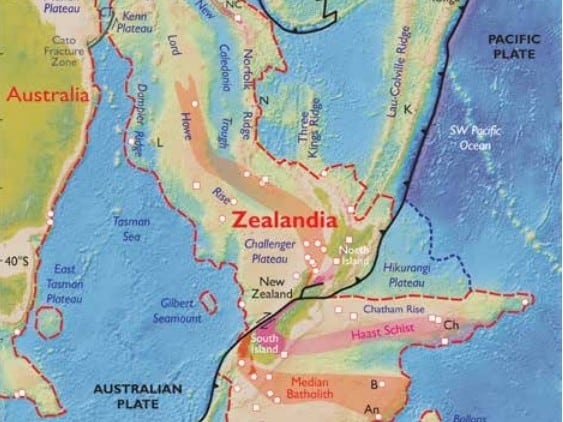
 An eighth continent? It seems like the geologists of the world are having a bit of a party lately.
An eighth continent? It seems like the geologists of the world are having a bit of a party lately.
Last month, there was the announcement that a “lost continent” had been discovered under and around the island of Mauritius in the Indian Ocean.
Researchers had stumbled upon zircon rocks found on the island which confirmed that Mauritius, along with a scattering of other islands in the region, represented a piece of continent that had broken off from Madagascar at the time when the ancient supercontinent, Gondwana, split apart to form Africa, India, Australia and Antarctica, about 200 million years ago.
Now, a group of geologists from New Zealand and Australia are pushing for the recognition of another, mostly submerged, lost continent dubbed Zealandia, a land mass two-thirds the size of Australia and lying beneath the islands of New Zealand and New Caledonia. Today, the would-be continent is 94 per cent underwater, yet researchers claim that recently as 23 million years ago, Zealandia was fully above water and, thus, that it deserves the title of Earth’s eighth (hidden) continent.
“The 4.9 Mkm2 area of continental crust is large and separate enough to be considered not just as a continental fragment or a microcontinent, but as an actual continent—Zealandia,” say the researchers whose work is published in GSA Today, the journal of the Geological Society of America.
But what defines a continent, you ask, and who decides these things? The latter issue is a bit unclear, as there is no international body appointed to make such calls, unlike, say, the International Astronomical Union, which has assumed the role of planet-namer (leading to the demotion of Pluto to dwarf planet status, for one).
Fortunately, the attributes which characterize continents are a little more clearly delineated: simply put, continents are large land masses made up of continental-type crust. Specifically, the kinds of rocks that make up continents are very old, contrasting with the rocks that make up islands derived from oceanic crust, which are very new, geologically speaking.
The difference is telling. The reason why the lost continent below Mauritius has now come into discussion is that the aforementioned zircons found on Mauritius were dated at three billion years old, while the island itself is thought to be only nine million years old. Thus, scientists argue that Mauritius must be sitting on top of a piece of continental crust as opposed to oceanic crust.
The submerged Zealandia, too, is said to be composed of lighter, continental-crust rocks like granite rather than the heavier volcanic basalt that makes up oceanic plateaus, which gives it a passing grade on that part of the definition of a continent.
Further, the authors argue that Zealandia is separate continent from close-by Australia, divided as they are by the deep Cato Trough, a 25 km-wide and 3,600 m-deep chasm on the ocean floor. Thus, unlike Greenland, for example, which despite its size is defined as part of the North American continental geology because its continental crust is connected under Nares Strait to the continental crust of Ellesmere Island and the rest of Nunavut in Canada’s North.
But what about the “large land mass” part? Can you really say that Zealandia is a “land” mass if most of it is underwater? A trifling detail, asks Nick Mortimer, geologist at GNS Sciences in Dunedin, New Zealand, and team leader on the new study. “If you could pull the plug on the world’s oceans, then Zealandia would probably long ago have been recognized as a continent,” says Mortimer.
Others are less convinced, however, with some claiming that at best, Zealandia could be given micro-continent status, as has been placed on Madagascar. “My judgment is that though Zealandia is continental, it is not a continent,” says Christopher Scotese, geologist at Northwestern University, to National Geographic.
Continental, microcontinent or the full monty, we’ll leave it up to the big brains to fight it out. The label, in fact, is less significant than the science behind the discussion. Lewis Ashwal, lead author of the research on Mauritius’ lost continent, puts it this way: “Our work is addressing the question of how continents break apart from each other and how new oceans are formed,” says Ashwal to the CBC. “If we are able to reconstruct their positions in the past, where they were and at what time in the past, then we can understand better how the earth works.”
Leave a Reply
You must be logged in to post a comment.




 Share
Share Tweet
Tweet Share
Share




Comment